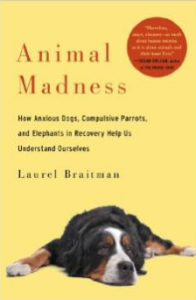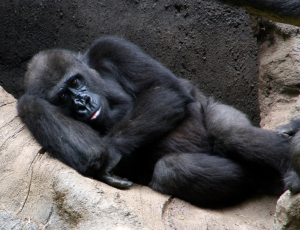 “Given my choice, I would almost always choose to be a feral dog. Maybe you don’t live as long, maybe you don’t have shots, maybe you have mange, but I would choose that in a hot second over waiting for twelve hours for my person to come home for a half hour walk or a trip to the dog park” shared Laurel Braitman in a recent interview by my friend Barbara Dobbins (from The Whole Dog Journal). Laurel Braitman is the author of the book Animal Madness: How Anxious Dogs, Compulsive parrots, and Elephants in Recovery Help Us Understand Ourselves. She takes us on a journey into the animal’s psyche, when stress, living conditions, genetics or all of the above lead to mental distress and sometimes even to “Crazytown”. A fascinating, yet difficult and upsetting book to read. When dogs, cats, mice, parrots, pigs, elephants and people loose their mind, they’ve entered a world of psychological pain, fear, anxiety or panic. Their reality no longer makes sense to others but it’s their way of coping with life. Her position is strong: according to Braitman, animals shouldn’t be kept in zoos. We should not be “eating mentally ill pigs, chicken and cows, and do away with corporate farming practices so cruel they’re often institutionalized torture”. We should only keep animals that “thrive in our presence”. If they had the choice, they would certainly not live this way. But what about our pets? Aren’t pets used to living with us? Why do dogs lick themselves incessantly or frantically chase their tails? Why do cats suddenly start spraying around the house or attacking the visitors?
“Given my choice, I would almost always choose to be a feral dog. Maybe you don’t live as long, maybe you don’t have shots, maybe you have mange, but I would choose that in a hot second over waiting for twelve hours for my person to come home for a half hour walk or a trip to the dog park” shared Laurel Braitman in a recent interview by my friend Barbara Dobbins (from The Whole Dog Journal). Laurel Braitman is the author of the book Animal Madness: How Anxious Dogs, Compulsive parrots, and Elephants in Recovery Help Us Understand Ourselves. She takes us on a journey into the animal’s psyche, when stress, living conditions, genetics or all of the above lead to mental distress and sometimes even to “Crazytown”. A fascinating, yet difficult and upsetting book to read. When dogs, cats, mice, parrots, pigs, elephants and people loose their mind, they’ve entered a world of psychological pain, fear, anxiety or panic. Their reality no longer makes sense to others but it’s their way of coping with life. Her position is strong: according to Braitman, animals shouldn’t be kept in zoos. We should not be “eating mentally ill pigs, chicken and cows, and do away with corporate farming practices so cruel they’re often institutionalized torture”. We should only keep animals that “thrive in our presence”. If they had the choice, they would certainly not live this way. But what about our pets? Aren’t pets used to living with us? Why do dogs lick themselves incessantly or frantically chase their tails? Why do cats suddenly start spraying around the house or attacking the visitors?
When humans show signs of emotional instability, they can share their experience with a social worker a psychologist of psychiatrist. People can describe their fears and express their angst through language. Their diagnosis can be looked up in the Diagnostic and Statistical Manual of Mental Disorders (DSM), a guide used by practitioners around the world. When it comes to animals however, we don’t have any other tool besides observation and there is no animal version of DSM to help us identify what they might be suffering from. According to a number of veterinary behaviorists such as Dr Karen Overall, the late Dr. Mel Richardson, Dr. Carl Cottman and Dr. Nicholas Dodman, animals exhibit their own version of almost every human psychiatric condition. Elephants can be depressed when kept for years in small corrals without a companion. Chimps can have signs of trauma after having been used as test subjects in laboratories. But even when the animals have suffered no abuse whatsoever and are used to living in a human environment, they can still develop anxiety disorders, attachment disorders, PTSD, compulsive disorders, panic disorders, phobias, pica, self- mutilating habits, and depression.
 Certain abnormal behaviors are easier to recognize than others. We’ve all seen tigers and bears pacing along the sides of their enclosures. Stereotypical behaviors or stereotypies are repetitive, seemingly pointless behaviors and can come in many forms. Humans can cross and uncross their legs, touch oneself in certain ways or walk back and forth. I’ve know a number of women who run their fingers in their hair in the same way every time they were engaged in public speaking for instance. Generally these behaviors tend to get worse when we’re anxious or stressed. Horses are well known for taking small rhythmic gulps or air or to lick and chew fences. Pigs gnaw on one another’s tails; whales, seals and otters swim in stereotypical patterns. And of course, we all know of dogs compulsively licking a particular spot on their paw or flank, even if there is nothing there.
Certain abnormal behaviors are easier to recognize than others. We’ve all seen tigers and bears pacing along the sides of their enclosures. Stereotypical behaviors or stereotypies are repetitive, seemingly pointless behaviors and can come in many forms. Humans can cross and uncross their legs, touch oneself in certain ways or walk back and forth. I’ve know a number of women who run their fingers in their hair in the same way every time they were engaged in public speaking for instance. Generally these behaviors tend to get worse when we’re anxious or stressed. Horses are well known for taking small rhythmic gulps or air or to lick and chew fences. Pigs gnaw on one another’s tails; whales, seals and otters swim in stereotypical patterns. And of course, we all know of dogs compulsively licking a particular spot on their paw or flank, even if there is nothing there.
Between the US and Europe, we raise about 16 billion farm and laboratory animals every year. Millions of those animals develop abnormal behaviors according to Braitman’s research: 91.5% of pigs, 82.6% of poultry, 50% of lab mice, 80% of minks raised for fur and 18.5% of horses show signs of mental illness. Many engage in self-destructive or self-soothing behaviors ranging from constant rocking to compulsive masturbation, self-biting and self-picking. Such stereotypies almost never occur in the wild.
PTSD symptoms have been seen in dogs. Search and rescue dogs that have spent very long hours searching for people amongst the rubble after 9/11 as well as dogs rescued after hurricane Katrina suffered from extreme anxiety triggered by any sight or sound that resembles those experienced during the traumatic event. Some dogs chase their tails in their back yards to the point of drawing distinct crop circles. Others are scared of the strangest things that would seem otherwise quite harmless, like lights, beeping noise from alarms or microwaves, flies, etc. My own dog is very comfortable having her nails trimmed, yet will run and hide if I clip my own nails. Compulsive behaviors are also fairly common amongst animals. But unlike humans, they can’t share their thoughts. Since we can’t prove that they have obsessive thoughts while they’re licking themselves or other objects, when it comes to animals we only refer to the disorder as a compulsive disorder.
 In humans, anxiety disorders are so common that we all stand a 10 to 20% chance of experiencing extreme anxiety or panic attack in our lifetime! It shouldn’t be surprising therefore that our pets have similar problems. Separation anxiety is for instance one of the most common reasons why dog guardians consult with a behaviorist. Some cases are so severe, according to Braitman, that if they were humans, they would be hospitalized! But unlike people who may suffer separation anxiety while growing up and separated from a parent or loved one, dogs can develop separation anxiety at any age. Being alone can be very distressing to a dog and many will try to escape. Some dogs show signs of such extreme panic that they probably feel like they’re in a life or death situation. Contrary to children though, the presence of any human can help them calm down, not just their primary person.
In humans, anxiety disorders are so common that we all stand a 10 to 20% chance of experiencing extreme anxiety or panic attack in our lifetime! It shouldn’t be surprising therefore that our pets have similar problems. Separation anxiety is for instance one of the most common reasons why dog guardians consult with a behaviorist. Some cases are so severe, according to Braitman, that if they were humans, they would be hospitalized! But unlike people who may suffer separation anxiety while growing up and separated from a parent or loved one, dogs can develop separation anxiety at any age. Being alone can be very distressing to a dog and many will try to escape. Some dogs show signs of such extreme panic that they probably feel like they’re in a life or death situation. Contrary to children though, the presence of any human can help them calm down, not just their primary person.
But according to Temple Grandin, “just because an animal isn’t compulsively pacing, chewing or repeatedly gnawing someone else’s tail, doesn’t mean the animal is happy”. Some animals can withdraw when stressed instead of being destructive for instance. Such animals won’t be diagnosed even if they are suffering as much as their counterparts.
Why do animals develop such behaviors? What leads animals to the point of madness?
There are 3 main factors:
- Breeding for specific physical traits increases the chances of problematic behaviors being passed down in the genetic pool. As Braitman points out: “ a parallel in human breeding would be deeply disturbing”. Specific markings and proportions can be connected to other traits, such as fearfulness, anxiety or aggression. Certain breeds for instance are prone to specific disorders. Bull terriers, Terriers and Border Collies, are susceptible to tail-chasing compulsions; Old Engligh Sheepdogs, Wirehead Fox Terriers and Rottweilers may chase patches of light; German Shepherds, Cavalier King Charles Spaniels and Norwich Terriers have a higher tendency than others to snap at flies that do not exist, etc.
- Abuse and neglect can have lasting effects on an animal. In the early phases of development, when the neural pathways are developing, allowing for memories, decisions, emotions and other mental experiences to take place, if some of the synapses or neuronal pathways are not used or if they are bathed in high levels of stress hormones, they will atrophy. As a result, the animal may suffer serious and lasting emotional problems. When pups have suffered abuse of neglect, their chance of developing into confident and well-adjusted adults is compromised. They can be harder to live and work with and can be more aggressive, increasing their chance to end up at the pound.
- Today, most of us live in small spaces and work long hours. When we leave for work in the morning, we want to believe that our dog is peacefully curling up in his bed, playing with his toys or checking out the window. According to Braitman, such expectations are simply not fair! As a result of our urban lifestyle, dogs spend too many hours doing nothing. Without satisfying energy outlets, they may develop various types of mental illness.
In her quest to better understand her dog Oliver’s severe separation anxiety, Braitman travelled the world, visited places many of us would rather avoid and talked to professionals who deal with mental illness on a day to day basis. At the end of the day, her views are strong and her position on animal welfare can seem controversial to many. Some of her opinions expressed in this blog are not necessarily shared by Smart Animal Training Systems. Her book is a great read however and I recommend it to anyone interested in understanding how animals, but also how people can sometimes loose our mind…
As Darwin pointed out over a 150 years ago, the difference between humans and other animals is only a matter of degree. What can send a human into the ramblings of mental illness is likely to have similar effects in another species. We cannot force distressed psyches into situations that they may not be able to handle. “What shocked and continues to amaze me”, shared Braitman, “is that I think we are special in terms of the level of empathy we extend to other creatures when we recognize they are suffering. And that is an amazing thing! Certainly we’re not alone in empathy, but we are in the extent and the extremes we go to in order to help other creatures. That is just a magical thing about humans. At the end of the day, recognizing this is such an act of hopefulness because it’s about connecting to another creature. And we do that against all odds, again and again and again. We extend ourselves to such an unbelievable level to help these creatures.”
Jennifer Cattet Ph.D.


Hi Jennifer, thanks for sharing the TED Talk by Laurel Braitmen. I found her talk so interesting and it struck a chord with me in terms of human and animal mental health and well being on so many levels. Thanks also for your review of her book which I will certainly be purchasing.